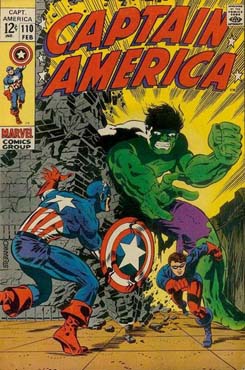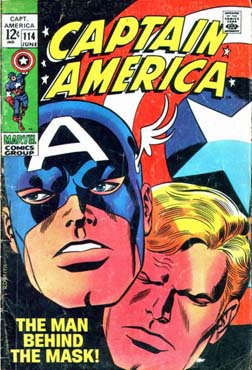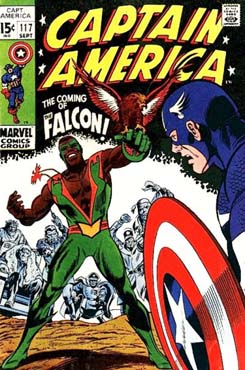 A perennial problem in comic-book storytelling is that the storytellers keep changing. Sometimes the series whipsaws in unpredictable and unsuccessful directions. Sometimes one writer’s plans get axed by their replacement. This was true even back in the Silver Age, as witness the strange story of Captain Marvel and Zo.
A perennial problem in comic-book storytelling is that the storytellers keep changing. Sometimes the series whipsaws in unpredictable and unsuccessful directions. Sometimes one writer’s plans get axed by their replacement. This was true even back in the Silver Age, as witness the strange story of Captain Marvel and Zo.
Along with the treacherous Yon-Rogg and Carol Danvers, the Silver Age supporting cast of Earth’s “space-born superhero” included the Kree medic Una, Mar-Vell’s Great Love. In Captain Marvel #11 (by Arnold Drake and Dick Ayers, with Barry Windsor-Smith doing the cover), a stray ray blast kills her during a battle between Yon-Rogg’s troops and the alien Aakon. After Mar-Vell buries his woman, the cosmic entity Zo offers to boost his power so that he can destroy Yon-Rogg. Once Mar-Vell has his revenge, the hero’s life and duty will belong to Zo forever.
Marv jumps at the chance and gets an upgrade that from the sound of it puts him close to Thor’s level of power. Unfortunately in the following issue Mar-Vell decides simply smashing through the Kree defenses and killing Yon-Rogg with his bare hands would be too good for the scum. Instead he winds up in a battle with an unstoppable robot and doesn’t seem any more powerful, other than being able to teleport.
I presume Drake wanted to get the captain away from Yon-Rogg’s intrigues and the soap opera/superheroics at Cape Canaveral. We’ll never know as this was Drake last issue, nor will we ever know his plans for Zo. Or for Una: a Yon-Rogg thought balloon declares she’s medically dead, not permanently dead, and he’ll revive her once Marv is disposed of. Surprisingly, nobody’s ever picked up on that; when she’s revived during Starlin’s run, it’s as a soulless zombie. Like I Ching and Linda Holland she doesn’t have enough screen presence anyone cares to bring her back.
Gary Friedrich then takes over and pays no more attention to Marv’s increased powers than Drake did. In #15, Zo finally calls in his marker. There is a fringe Kree religion on Hala, the cult of Tam-Bor; Zo wants Marvel to destroy the god’s sacred idol, even if he has to destroy Hala with it. When Marvel balks at annihilating his homeworld, Zo shows by awesome hallucinogenic visuals (or as hallucinogenic as artist Thomas Sutton can manage) that he’s God, or someone punching in the same weight class. Accepting Zo’s authority, Marvel heads to the Kree homeworld.
By the following issue, the creative team is Archie Goodwin and Don Heck. Once again I have no idea if their story used anything of what Friedrich had in mind (and of course Friedrich may have been winging it with no clue what came next). Mar-Vell’s efforts to destroy Tam-Bor run afoul of Ronan, a clash of titans that ends abruptly when they’re teleported to the Supreme Intelligence’s chamber.

Supremor then reveals that Zo’s display of cosmic awesomeness was merely some Wizard of Oz type trickery, with Ronan and Imperial Minister Zarek as the Kree behind the curtain (despite Zo being the reverse of Oz, I don’t know if Goodwin picked the name with that in mind or if any of these creators thought about it).

The plan was to frame Mar-Vell as a traitor, blame him for assassinating the Supreme Intelligence, then seize power. Despite being exposed, the bad guys drop a “negative bomb” in the throne room (Marv takes the blast to save his leader), then escape. Supremor assures Mar-Vell they’ll be caught, plus he’ll eliminate co-conspirator Yon-Rogg by blowing up Earth. When Mar-Vell objects humanity doesn’t deserve that, Supremor agrees to spare Earth, given how much he owes the captain. However he’s displeased to see Yon-Rogg’s accusations about Mar-Vell having divided loyalties aren’t groundless. The solution is — well, see the next panel.

Rereading Archie Goodwin’s Iron Man I’ve been really impressed by his work (a topic for another post). Here, too. Drake and Friedrich left him quite a lot to wrap up and he does so as well as could be expected. Even more impressive, he does quite a lot of mythos building in the process:
- Mar-Vell’s new outfit.
- The idea of the Supreme Intelligence as a collective mind.
- Mar-Vell’s connection to the Negative Zone. A side-effect of getting blasted by the bomb is that at the end of the issue he finds himself sucked into that dimension, with consequences I think everyone reading this is aware of.
- The introduction of the blue Kree. Up until Zarek, all the Kree have been lily white. Zarek asserts his racial stock is the original, pure-blood Kree, diluted by interbreeding with conquered races (though IIRC Steve Englehart’s later origin for the Kree showed the ancestral stock was pale skinned)
That’s a lot added to the canon.
Jim Steranko taking over Captain America as writer/artist, then leaving (voluntarily or not, I’ve no idea) wasn’t quite so drastic in effect but the shift from Steranko back to Stan Lee and various collaborators did have an effect. We got three Steranko issues (Lee and Jack Kirby did a filler in the middle)—



—then it was Stan and John Romita (who did the of 114 below) then John Buscema, then Gene Colan.
Steranko doesn’t get to run as wild here as he did in Nick Fury, Agent of Shield, but he does tell a dynamic story. Cap finally accepts Rick Jones as his new partner and struggles to tame Rick’s recklessness so the kid doesn’t end up as dead as Bucky. When it becomes obvious new Hydra leader Madame Hydra — the crime cartel has risen anew since Nick Fury destroyed it in his own series — will target Steve and his friends in their everyday life (Steve having recently unmasked and retired), Steve fakes his death, leaving behind a latex Steve Rogers mask. OMG — he wasn’t Captain America after all!
Once again, I’ve no idea what Steranko had in mind (if anyone does, feel free to mention it in comments). Lee, to his credit, deals with the consequences of Steve’s death rather than handwaving them away. Cap’s started over in a new identity but he has no references, no documentation, no money (he doesn’t seem to have planned very well). In modern America, that means no life.

Unfortunately, Lee doesn’t deliver on the action side of things. He has the Red Skull return (cover below y Marie Severin) having recovered the Cosmic Cube (from his synopsis, Lee seems to have forgotten Sub-Mariner picked the cube up after the Red Skull first used it). The Skull proceeds to go full-on “I could crush you with a second’s thought — but it will be more fun to toy with you as there is no way you can possibly ever be a threat to me now, no matter how many times I’ve thought that before and been wrong.”

Lee’s writing is close to the “phoning it in” level. However this arc does give us the Big Two’s first African American superhero (seen for the first time on this Colan cover).

That’s way better than Rick Jones as Bucky would have been.
Nick Fury’s strip had a small degree of whiplash following the wrap-up of Gary Friedrich and Frank Springer’s Hate-Monger three-parter. In the following issue, Steve Parkhouse and Barry Windsor-Smith have Fury under investigation for no clear reason (even given it’s a Hydra frame-up), then forced to go on the run when he apparently murders the chief investigator.

Gary Friedrich and Herb Trimpe take over with the following issue (Parkhouse would go on to do a fair amount of work for Marvel’s UK line), and while Nick’s still on the run the focus is on the new villain, the Super-Patriot.

He’s a depressingly familiar type, a right-wing extremist pushing back against all the changes of the 1960s that had supposedly ruined America. At the finish, Nick unmasks the villain and it’s … Nick Fury! As we learn in the following issue, however, it’s all just a hallucinatory mindscape (one of my least favorite tropes)

My first thought was that once again a new writer was ditching the previous creators’ plot but nope, this is still Friedrich and Trimpe. Did they have this twist in mind when they wrote the previous issue? Did they intend to reveal the Super-Patriot as an LMD, then course-correct (there’s another LMD replacing Tony Stark in Iron Man at this time — perhaps Stan decided one was enough). Once again, all I can do is speculate.
In case you’re wondering, the bearded shrink is another villain, working to destroy Fury from within. Spoiler: he fails.


Ah, that explains the ur-Kree being white in Englehart’s retelling: a colorist’s error (https://50yearoldcomics.com/2025/01/18/avengers-134-april-1975/)
Alan Stewart recently catalogued some coloring decisions that might explain the Blue Kree/White Kree idea: https://50yearoldcomics.com/2025/04/26/captain-marvel-39-july-1975/